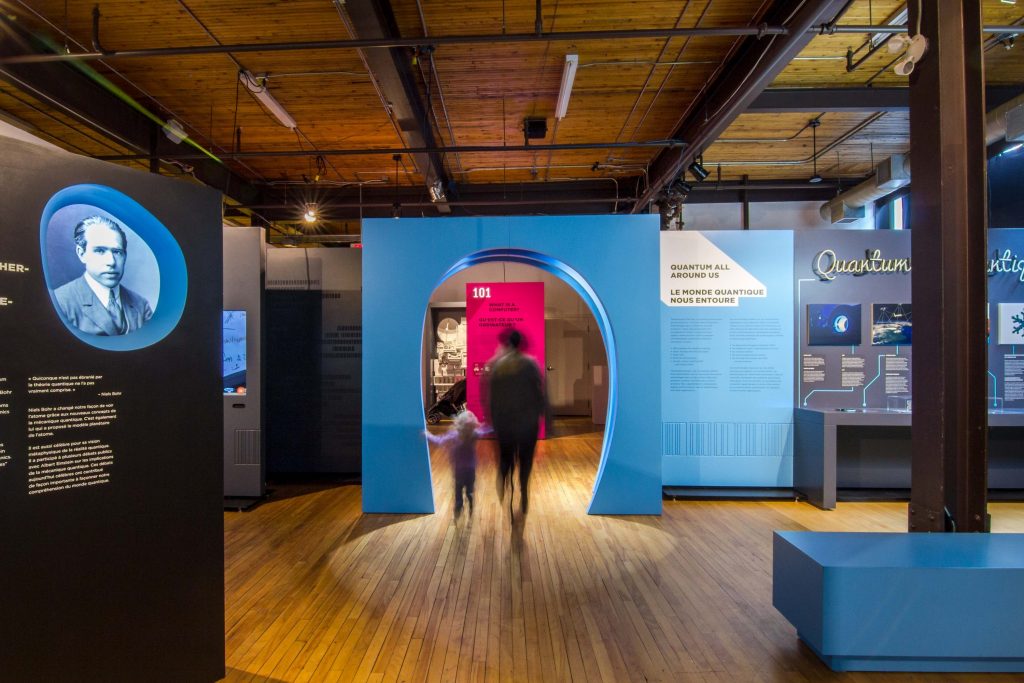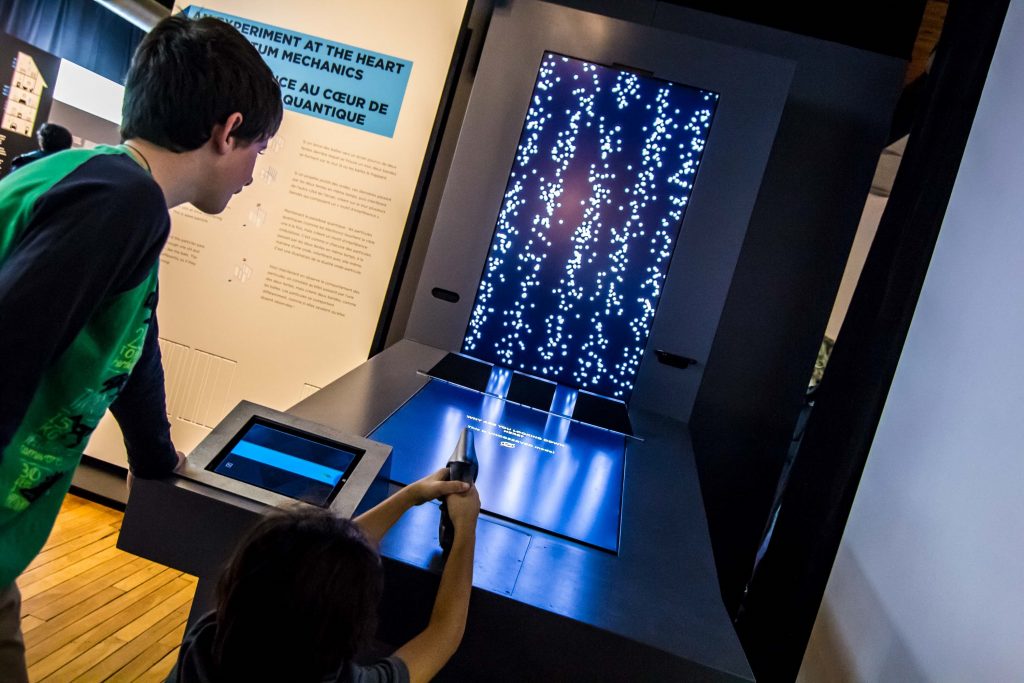Lauren Borja, Physics & Astronomy editor
In celebration of Canada’s 150th anniversary, a traveling exhibit on quantum mechanics and technology is touring science centers and museums across the nation. QUANTUM: The Exhibition explains these concepts in an easy-to-understand and hands-on way. From Vancouver to Halifax – with stops in Calgary, Saskatoon, Kitchener, and Ottawa – people of all ages can explore quantum mechanics for themselves.
But why is it important for people to engage with quantum mechanics? This question was at the back of my mind when I sat down with two of the exhibit’s creators, Tobi Day-Hamilton of Strategic Initiatives and Martin Laforest, the Senior Manager of Scientific Outreach of the University of Waterloo’s Institute for Quantum Computing. From getting people to recognize quantum mechanics in their lives to giving Canadians pride in our country’s contributions to the scientific advances made in this field, they described many reasons to visit the exhibition and explore quantum mechanics.
Quantum mechanics in the lives of people today and tomorrow
“People don’t really recognize that a lot of the technology that we use today [is] made possible because of quantum mechanics,” says Laforest, himself a quantum physicist. Examples of technology using quantum mechanics range from GPS mobile phone apps to MRI machines. The exhibit aims to inspire a fascination with the concept of quantum mechanics and extol its benefits.
Visitors young and old enjoy the exhibition. Photo credit: IQC.
Many of our current devices use quantum mechanics, and applications using its innovations will only continue to grow. Innovations like quantum computing, quantum cryptography and quantum sensing will either drastically improve or completely change how we perform certain tasks. For example, a quantum computer is a machine that manipulates the quantum properties of matter to perform certain calculations much faster than the “traditional” computers we use every day. We could use these computers to develop better pharmaceuticals by speeding up the modeling of potential disease-fighting medicines. Quantum cryptography could be used to make money that is impossible for counterfeiters to copy or to protect information, like credit card numbers, that we send over the internet.
The rise of quantum computing is rumored to be imminent – Google, Microsoft and IBM are investing heavily in the technology and competing to be the first to sell a commercial quantum computer. Why the rush? D-Wave, a Canadian start-up in Burnaby, BC, and the only company currently selling machines for quantum computing, has demonstrated that there is a market for such devices – even if some people in the field don’t consider D-Wave’s product a quantum computer. This skepticism has not stopped groups like NASA and Google from purchasing D-Wave’s computers.
Exposing Canada’s quantum excellence
Canada’s leadership extends beyond D-Wave and is largely driven by prioritizing research into quantum technologies. “Canada as a nation has been punching way over its weight for a decade and a half on this type of research,” says Laforest. Canada’s investment into non-classified research in this area is on par with Britain and Germany, both of which have significantly higher Gross Domestic Products. Canada also ranks in the top ten for patent applications in the separate areas of quantum computing, quantum cryptography and quantum sensors.
Canada’s early investment is beginning to pay off and it is well positioned to stay at the forefront of the quantum technology field. The Institute of Quantum Computing (IQC) at the University of Waterloo was created in 2002 and expanded into new state of the art facilities costing $160 million in 2012. At the University of British Columbia, the Quantum Matter Institute was established in 2010 and received over $60 million from the Canadian government. The Institut quantique at the Université de Sherbrooke won a $33.5 million dollar grant from the Canada First Research Excellence Fund. These are big investments and “an opportunity for Canada to be a leader in the next big technological shift,” according to Laforest.
Many other Canadian universities also house excellent quantum research, and the travelling nature of the exhibit offers a unique way to let them take part. Researchers from IQC were invited to the opening of QUANTUM: The Exhibition at THEMUSEUM, where they mingled with museum members. When the exhibition stopped in Vancouver’s TELUS World of Science, graduate students from the nearby Quantum Matter Institute led additional hands-on experiments and activities on the weekends. Laforest and Day-Hamilton hope to continue this local involvement as the exhibit makes its way across Canada.
Sponsors’ spotlight
As producers of the exhibit, there’s a lot Laforest and Day Hamilton can be proud of when they walk through QUANTUM: The Exhibition. A couple of specific pieces stand out as their favorites and visitors might want to pay special attention to them.
Day-Hamilton said that she thinks of “the video that explains quantum computing in sixty seconds.” Laforest and Day-Hamilton wanted to come up with their own short explanation after Prime Minister Justin Trudeau threw down the gauntlet last April. Day-Hamilton said that she hopes Canadians can “take it away and use it themselves,” promising that “it’s not too hard to understand.”
Despite initially responding “all of it,” Laforest says his favorite part is the “interactive [display] that explains the concept of [quantum] superposition.” Superposition is the ability of qubits in a quantum computer to be in more than one state simultaneously. It can be difficult to conceptualize using words, but it makes more sense after you interact with something in a quantum superposition, as in this display. “People are very surprised by what they see,” says Laforest.
Interacting with a quantum exhibit. Photo credit: IQC
QUANTUM: The Exhibition was produced by the IQC at the University of Waterloo as part of Innovation150, which celebrates Canadian achievements as part of the 150th anniversary of the Confederation. The Perimeter Institute, Actua, the Canadian Association of Science Centres, and the Canadian Science and Technology Museums Corporation also sponsor Innovation 150.
*Header Image: A neon sign in QUANTUM: The Exhibition. Photo credit: Institute for Quantum Computing.






